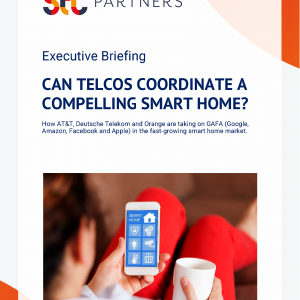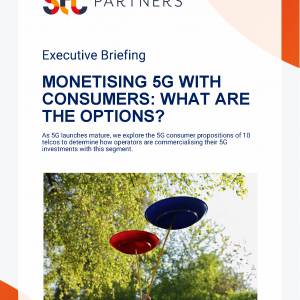The Future Value of Voice and Messaging
£1,000.00 excl VAT
Our new research shows how telcos can slow the decline of voice and messaging revenues and build new communications services to maximise revenues and relevance with both consumer and enterprise customers. It includes detailed forecasts for 9 markets, in which the total decline is forecast between -25% and -46% on a $375bn base between 2012 and 2018, giving telcos an $80bn opportunity to fight for. It also shows impacts and implications for other technology players including vendors and partners, and general lessons for competing with disruptive players in all markets. It looks at the impact of so-called OTT competition, market trends and drivers, bundling strategies, operators developing their own Telco-OTT apps, advanced Enterprise Communications services, and the opportunities to exploit new standards such as RCS, WebRTC and VoLTE. (November 2013, Executive Briefing Service). Future Value of Voice and Messaging Cover Small
Description
Format: PDF filePages: 261 pagesCharts: 163Author: Andrew CollinsonPublication Date: November 2013
Table of Contents
- Executive Summary. (18 pages outlining the opportunity and key strategic options)
- Disruption and transformation, voice vs. telephony, and scope.
- The Transition in User Behaviour. Global psychological, social, pricing and segment drivers, and the changing needs of consumer and enterprise markets.
- What now makes a winning Value Proposition? The fall of telephony, the value of time vs telephony, presence, Online Service Provider (OSP) competition, operators’ responses, free telco offerings, re-imaging customer service, voice developers, the changing telephony business model.
- Market Trends and other Forecast Drivers. Model and forecast methodology and assumptions, general observations and drivers, ‘Peak Telephony/SMS’, fragmentation, macro-economic issues, competitive and regulatory pressures, handset subsidies.
- Country-by-Country Analysis. Overview of national markets. Forecast and analysis of: UK, Germany, France, Italy, Spain, Taiwan, Singapore, Canada, US, other markets, summary and conclusions.
- Technology: Products and Vendors’ Approaches. Unified Comminications. Microsoft Office 365, Skype, Cisco, Google, WebRTC, Rich Communications Service (RCS), Broadsoft, Twilio, Tropo, Voxeo, Hypervoice, Calltrunk, Operator voice and messaging services, summary and conclusions.
- Telco Case Studies. Vodafone 360, One Net and RED, Telefonica Digital, Tu Me, Tu Go, Bluvia and AT&T.
- Summary and Conclusions. Consumer, enterprise, technology and Telco OTT.
Table of Figures
- Figure 1: Voice and Messaging revenue scenarios
- Figure 2: Mobile Text – Price Vs. Usage
- Figure 3: Spain SMS volume vs. average price
- Figure 4: SMS Price vs. penetration of Top OSP Messaging Apps
- Figure 5: Mobile Voice – Pricing Vs. Usage
- Figure 6: EU 5 Pessimistic Forecast
- Figure 7: EU5 Optimistic Forecast
- Figure 8: Wi-Fi vs. cellular originated traffic – Android smartphones
- Figure 9: UK SMS volume vs. average price/msg
- Figure 10: USA vs. Average
- Figure 11: Germany – High Wealth & Low Telephony
- Figure 12: Big prices = Small talk
- Figure 13: Distribution of Android smartphone originated traffic across cellular and WiFi networks by country
- Figure 14: Psychological and social advantages of voice, SMS, IM, and Social Media
- Figure 15: Ideal Enterprise mobile call routing scenario
- Figure 16: Mobile Clients used to bypass high mobile call charges
- Figure 17: Call Screening Options
- Figure 18: Mobile device user context and data source
- Figure 19: Typical business user modalities
- Figure 20: OSPs are pursuing platform strategies
- Figure 21: Subscriber growth of KakaoTalk
- Figure 22: Average monthly minutes of use by market
- Figure 23: Key features of Voice and Messaging platforms
- Figure 24: Average user screen time Facebook vs. WhatsApp (per month)
- Figure 25: Disruptive price competition also comes from operators
- Figure 26: The hunger gap in music
- Figure 27: North America outdoes Western Europe
- Figure 28: Mobile voice price Vs. Usage
- Figure 29: Taiwan key indicators vs. Market average
- Figure 30: Vodafone revenue highlights market issues
- Figure 31: Vodafone UK Revenue Q4 11/12 vs Q4 12/13
- Figure 32: Vodafone Italy revenue Q4 11/12 vs Q4 12/13
- Figure 33: Bloodbath in Europe
- Figure 34: Vodafone’s success with data barely compensates for messaging, let alone voice
- Figure 35: Increase in International Phone & Skype Traffic 2005-2012
- Figure 36: How accurate is STL Partners forecast for the global telecoms Industry in 2020
- Figure 37: Spain SMS volume vs. average price per message
- Figure 38: Average user screen time by market – WhatsApp (per month)
- Figure 39: Vodafone is aggressively moving users to bundled (“integrated”) plans
- Figure 40: Annual Mobile call minutes per subscription
- Figure 41: Average per-user SMS volume trends (msgs per year)
- Figure 42: Average per-user telephony trends (mins per year)
- Figure 43: Effective overall price/min mobile telephony, US cents
- Figure 44: Telephony price/usage elasticity
- Figure 45 – Spain and France telephony usage vs price
- Figure 46: Fixed lines / person vs. Mobile Penetration
- Figure 47: GDP / Person Vs. Smartphone %
- Figure 48: The UK has higher smartphone penetration, and lower post-pay than average
- Figure 49: UK – Personal wealth and Telecoms Spend
- Figure 50: UK – % Fixed Lines / Person Vs. % Smartphone
- Figure 51: UK Key Indicators – Mobile use
- Figure 52: UK Key Indicators – Mobile price comparisons
- Figure 53: Base forecast for total UK market
- Figure 54: UK Fixed Voice Historic + Forecast
- Figure 55: UK Mobile Voice Historic + Forecast
- Figure 56: UK Messaging Historic + Forecast
- Figure 57: Germany has relatively low telephony indicators despite average personal wealth
- Figure 58: German Key Indicators – Mobile use
- Figure 59: German Key Indicators – Mobile price comparison
- Figure 60: Germany: Personal wealth and Telecoms Spend
- Figure 61: Germany: % Fixed Lines / Person Vs. % Smartphone
- Figure 62: German fixed telephony volume still larger than mobile
- Figure 63: German mobile revenues dropping in recent quarters
- Figure 64: Base forecast for total German market
- Figure 65: Germany Fixed Voice Historic + Forecast
- Figure 66: Germany Mobile Voice Historic + Forecast
- Figure 67: Germany Messaging Historic + Forecast
- Figure 68: France has a higher fixed line penetration but lower spend / line than average
- Figure 69: France: Personal wealth and Telecoms Spend
- Figure 70: France: % Fixed Lines / Person Vs. % Smartphone
- Figure 71: France Key Indicators – Mobile use
- Figure 72: France Key Indicators – Mobile price comparison
- Figure 73: Orange France losing out to Free
- Figure 74: Base forecast for total French market
- Figure 75: France Fixed Voice Historic + Forecast
- Figure 76: French mobile telephony volumes are still rising
- Figure 77: France Mobile Voice Historic + Forecast
- Figure 78: French SMS volumes still growing strongly
- Figure 79: France Messaging Historic + Forecast
- Figure 80: Italy has lower than average personal wealth and low telephony indicators to match
- Figure 81: Italy: Personal wealth and Telecoms Spend
- Figure 82: Italy: % Fixed Lines / Person Vs. % Smartphone
- Figure 83: Italy Key Indicators – Mobile Spending
- Figure 84: Italian Key Indicators – Mobile price comparison
- Figure 85: Vodafone Italy: painful revenue declines
- Figure 86: Base forecast for total Italian market
- Figure 87: Italy Fixed Voice Historic + Mobile
- Figure 88: Italy Mobile Voice Historic + Forecast
- Figure 89: Italy Messaging Historic + Forecast
- Figure 90: Despite a weaker economy, Spain’s mobile indicators are close to average
- Figure 91: Spain: Personal wealth and Telecoms Spend
- Figure 92: Spain: % Fixed Lines / Person Vs. % Smartphone
- Figure 93- Spain Key Indicators – Mobile use
- Figure 94: Spain Key Indicators – Mobile price comparison
- Figure 95: Smartphone traffic distribution: originated data
- Figure 96: Vodafone Spain results are painful
- Figure 97: Base forecast for total Spanish market
- Figure 98: Spain Fixed Voice Historic + Forecast
- Figure 99: Spain Mobile Voice Historic + Forecast
- Figure 100: Spain Messaging Historic + Forecast
- Figure 101: Taiwan has very high telephony spend in relation to personal wealth,
especially in mobile - Figure 102: Taiwan: Personal Wealth and Telecoms Spend
- Figure 103: Taiwanese % Fixed Lines / Person Vs. % Smartphone
- Figure 104: Taiwan Key Indicators – Mobile use
- Figure 105: Taiwan Key Indicators – Mobile price comparison
- Figure 106: Mobile voice volume has overtaken fixed since 2007
- Figure 107: Base forecast for total Taiwanese market
- Figure 108: Taiwan Fixed Voice Historic + Forecast
- Figure 109: Taiwan Mobile Voice Historic + Forecast
- Figure 110: Taiwan Messaging Historic + Forecast
- Figure 111: Singapore is wealthy and has a high smartphone penetration
- Figure 112: Singapore Personal wealth and Telecoms Spend
- Figure 113: Singapore % Fixed Lines / Person Vs. % Smartphone
- Figure 114: Singapore Key Indicators – Mobile use
- Figure 115 Singapore Key Indicators – Mobile price comparison
- Figure 116: Base forecast for total Singaporean market
- Figure 117: Singapore Fixed Voice Historic + Forecast
- Figure 118: Singapore Mobile Voice Historic + Forecast
- Figure 119: Singapore Messaging Historic + Forecast
- Figure 120: Average Mobile Voice c
- harges by market (cost per minute)
- Figure 121: Canada is wealthy and has high fixed line and post-paid mobile
penetration - Figure 122: Canadian Personal Wealth and Telecoms Spend
- Figure 123: Canadian % Fixed Lines / Person Vs. % Smartphone
- Figure 124: Canada Key Indicators – Mobile use
- Figure 125: Canada Key Indicators – Mobile price comparison
- Figure 126: Base forecast for total Canadian market
- Figure 127: Canada Fixed Voice Historic + Forecast
- Figure 128: Canada Mobile Voice Historic + Forecast
- Figure 129: Canada Messaging Historic + Forecast
- Figure 130: The US is wealthy and has high overall telephony and fixed line spend per
person - Figure 131: US: Personal Wealth and Telecoms Spend
- Figure 132: US: % Fixed Lines / Person Vs % Smartphone
- Figure 133: US Key Indicators – Mobile use
- Figure 134: US Key Indicators – Mobile price comparison
- Figure 135: Base forecast for total US market
- Figure 136: USA Fixed Voice Historic + Forecast
- Figure 137: Wireless services spending by category in the USA
- Figure 138: USA Mobile Voice Historic + Forecast
- Figure 139: USA Messaging Historic + Forecast
- Figure 140: Closing the voice-focused iDEN system drove churn on Sprint’s mainline
network - Figure 141: Finland Telephony & Messaging Statistics
- Figure 142: Vodafone Voice and Messaging by Market
- Figure 143: Overall telephony & SMS revenue forecasts, US$bn, baseline scenario
- Figure 144: Basic user needs from Unified Communications
- Figure 145: Microsoft Lync 2013 client
- Figure 146: Microsoft Lync telephony integration options
- Figure 147: International Telephone and Skype Traffic 2005-2012
- Figure 148: The Skype effect on international traffic
- Figure 149: Voice call charging in USA
- Figure 150: Google Voice call charging in USA
- Figure 151: Google Voice call charging in Europe
- Figure 152: Google outbound call rates
- Figure 153: Calliflower beta support for WebRTC
- Figure 154: Active individual user base for WebRTC, millions
- Figure 155: Battery life compared for different services
- Figure 156: Vodafone One Net Express call routing
- Figure 157: Vodafone One Net Business Call routing
- Figure 158: Enterprise is a significant part of Vodafone group revenue
- Figure 159: Vodafone Red Bundles
- Figure 160: Telefonica: Market Positioning Map, Q4 2012
- Figure 161: US market in transition towards greater competition
- Figure 162: Voice ARPU at AT&T, fixed and mobile
- Figure 163 – Industry Value is Concentrated at the Interfaces
Technologies and industry terms referenced include: 2, APIs, AT&T, Best practice, Broadsoft, business, calls, Calltrunk, CEBP, cisco, Communications Enabled Business Processes, digital, economics, Enterprise Communications Services, facebook, forecasts, future, google, Hypervoice, Innovation, Insights, kakaotalk, LINE, Messaging, microsoft, minutes, mobile, model, Networks, Office 365, One Net, Online Service Providers, OSPS, OTT, Over The Top, Players, rcs, RED, Rich Communications Service, Skype, Strategic Position, Strategy, Telco, Telco OTT, Telecoms, Telefonica, texts, tropo, Tu Go, Tu Me, twilio, Twitter, unified communications, Value, Vodafone, Voice, VoIP, VoLTE, Voxeo, WebRTC, WhatsApp


